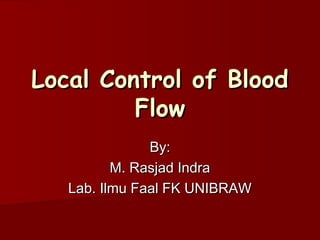Pengendalian aliran darah
•Als PPT, PDF herunterladen•
1 gefällt mir•885 views
Melden
Teilen
Melden
Teilen

Empfohlen
Empfohlen
Weitere ähnliche Inhalte
Was ist angesagt?
Was ist angesagt? (20)
Renin-Angiotensin-Aldosterone System- Drugs Overview.

Renin-Angiotensin-Aldosterone System- Drugs Overview.
Nervous control of blood vessels regulation of arterial pressure

Nervous control of blood vessels regulation of arterial pressure
Andere mochten auch
Andere mochten auch (19)
Progressive Effect Of Endurance Training On Metabolic Adaptations In Working ...

Progressive Effect Of Endurance Training On Metabolic Adaptations In Working ...
Bioc hemistry_ Regulation and integration of Metabolism

Bioc hemistry_ Regulation and integration of Metabolism
Ähnlich wie Pengendalian aliran darah
Ähnlich wie Pengendalian aliran darah (20)
Preclinical Screening of Antihypertensive Agents | In-Vitro & In-Vivo Models

Preclinical Screening of Antihypertensive Agents | In-Vitro & In-Vivo Models
Mehr von Risky Indra Kurniawan
Mehr von Risky Indra Kurniawan (15)
Pengendalian aliran darah
- 1. Local Control of Blood Flow By: M. Rasjad Indra Lab. Ilmu Faal FK UNIBRAW
- 2. Introduction The greater the metabolism the greater its blood flow – Liver: 95 ml/min/100 g of liver tissue. – Kidneys: 1100 ml/min cleansing the blood. The importance of blood flow control effective & efficient – Serving metabolic need – Efficient heart workload.
- 3. Mechanism of Blood Flow Control Acute control (rapid changes in local vasodilatation / vasoconstriction): – Effect of tissue metabolism – The availability of oxygen changes. – Two basic theories: Vasodilator theory: adenosine; CO2; histamine; K+ & H+ Oxygen lack theory: vasomotion in metarterioles & precapillary sphincters. – Other nutrients besides Oxygen: – Lack of glucose vasodilatation – Vitamin B deficiency vasodilatation
- 5. The examples of acute metabolic control of local blood flow 1. Reactive hyperemia • Blocked (seconds – hours) unblocked • Blood flow increases to 4 – 7 times normal • Depends on how long it is blocked. 2. Active hyperemia • Tissue activity lack of nutrient & release vasodilator substances. • Local blood flow increases 20 times in muscle during heavy exercise.
- 6. Blood flow control & The arterial pressure changes Acute autoregulation theory: 1. The metabolic theory 2. The myogenic theory (still doubtful !!) Endothelial-Derived Relaxing Factor “EDRF” (NO): – Rapid flow of blood shear stress NO release relaxes the local arterial wall.
- 8. Long Term Blood Flow Regulation 1. Change in Tissue Vascularity – Reconstruction to meet the needs of the tissues – Role of Oxygen in Long-Term Regulation. – Vascular Endothelial Growth Factors: 1. VEGF 2. FGF 3. Angiogenin 2. Collateral Circulation:
- 9. Humoral Regulation of The Circulation 1. Vasoconstrictor Agents: 1. Norepinephrine & Epinephrine 2. Angiotensin 3. Vasopressin 4. Endothelin 2. Vasodilator Agents: 1. Bradikynin 2. Histamin 3. Effects of Ion & Other Chemical Factors 1. Calcium vasoconstriction 2. Potasium Vasodilatation 3. Magnesium powerful vasodilatation 4. Hydrogen vasodilatation 5. Acetate & Citrate mild degree vasodilatation
- 10. Humoral Regulation of The Circulation 1. Vasoconstrictor Agents: 1. Norepinephrine & Epinephrine 2. Angiotensin 3. Vasopressin 4. Endothelin 2. Vasodilator Agents: 1. Bradikynin 2. Histamin 3. Effects of Ion & Other Chemical Factors 1. Calcium vasoconstriction 2. Potasium Vasodilatation 3. Magnesium powerful vasodilatation 4. Hydrogen vasodilatation 5. Acetate & Citrate mild degree vasodilatation
